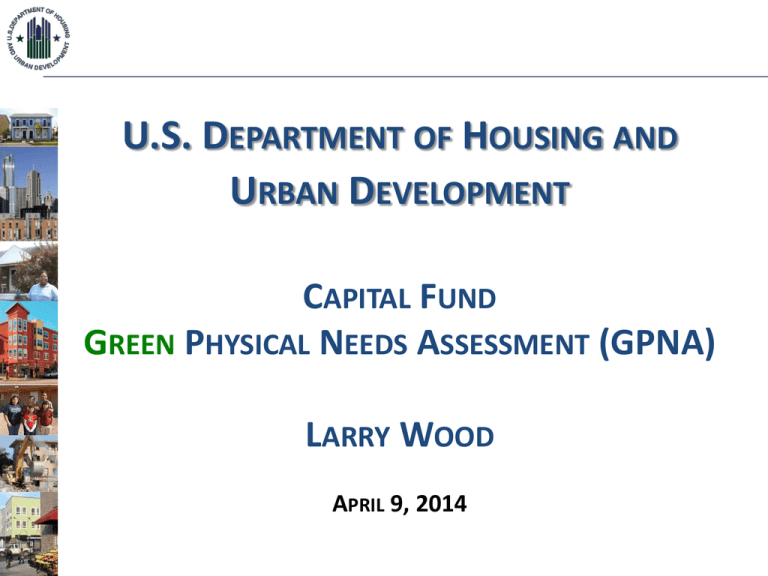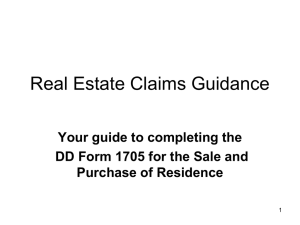PIH Field Office Training GPNA
advertisement

U.S. DEPARTMENT OF HOUSING AND URBAN DEVELOPMENT CAPITAL FUND GREEN PHYSICAL NEEDS ASSESSMENT (GPNA) LARRY WOOD APRIL 9, 2014 CAPITAL FUND – GPNA NEW HUD REQUIREMENTS Current Rule 24 CFR 905 – Capital Fund. Includes the formula, eligible expenses, obligations and expenditures, and Capital Fund Financing Program (CFFP). 2 CAPITAL FUND – GPNA NEW HUD REQUIREMENTS Rule Changes HUD published three proposed amendments to the Capital Fund regulation at 24 CFR 905 in 2010 and 2011: Consolidated 24 CFR 905. Merge development, old CIAP/CGP, and current Capital Fund requirements. Requires all PHAs to conduct a Physical Needs Assessment (PNA) as part of the Capital Fund requirements. 3 CAPITAL FUND – GPNA NEW HUD REQUIREMENTS Rule Changes Final Consolidated Capital Fund Rule at 24 CFR 905 published on October 24, 2013. Final Rule for GPNA and Energy Audit pending. Effective November 25, 2013. Will move Energy Audit requirement from 24 CFR 965 to 24 CFR 905. HUD to issue Implementation Notices once Final GPNA and Energy Audit Rules are published. Implementation Notice to give rollout details—when it will be effectective for which PHAs. 4 CAPITAL FUND – GPNA NEW HUD REQUIREMENTS GPNA All PHAs, regardless of size, must prepare and submit a GPNA to HUD. GPNA will include PHA-level summary information, as well as detailed data on each public housing project/Asset Management Project (AMP). GPNA will reflect current and future needs over a 20-year period based on life-cycle considerations. 5 CAPITAL FUND – GPNA NEW HUD REQUIREMENTS GPNA Will be conducted without regard to the amount of funding available to perform work identified in the PNA. The cost of the PNA is an eligible Capital Fund expense. Will be completed in the form and manner prescribed by HUD. PHAs must use the new GPNA software (the “GPNA Tool”) to submit PNA data to HUD. 6 CAPITAL FUND – GPNA NEW HUD REQUIREMENTS GPNA The first GPNA will be due on the basis of a schedule published in an implementation notice that will be issued concurrently with or after the final rule. HUD anticipates that PHAs will have a minimum of 6 months advance notice of the due date for their specific PNA data submittal. May include data from PNA collected up to 3 years prior to the submission due date for the first GPNA if the data meet new standards (e.g., 20-year assessment, integration with energy audit; see notice PIH 2010-46). 7 CAPITAL FUND – GPNA NEW HUD REQUIREMENTS GPNA Submission Dates First GPNA submittal due date no sooner than 6 months from publication of the PNA Rule. No due dates anticipated before December 1, 2014. All GPNAs submitted by September 2015 based on fiscal year. Fiscal Year End (FYE) Due Date March 31 December 1 June 30 March 2 September 30 June 2 December 31 September 1 Note that submission dates presented are examples. Actual submission dates will be per the Final Rule and subsequent Implementation Notice. The cycle of submission may vary in the initial submission. 8 CAPITAL FUND – GPNA NEW HUD REQUIREMENTS GPNA Example of timeline for submission to HUD: Assume Final Rule published: 4/30/2014. Effective date of Final Rule: 5/31/2014. First PNAs due after: 11/30/2014. Due date: 12/1/2014 (FYE- 3/31). 9 CAPITAL FUND – GPNA NEW HUD REQUIREMENTS GPNA PHA must use the software provided by HUD, known as the GPNA Tool. (GPNA produces the required format of submittal to HUD.) Must be performed in conjunction with energy audit and integrated in the GPNA. Energy audits done within 3 years of the due date of the initial GPNA will not have to be redone if they meet the new rule standards. After the GPNA is completed by the PHA, data extract will be emailed to HUD. 10 CAPITAL FUND – GPNA NEW HUD REQUIREMENTS GPNA After the first GPNA is completed, the PHA submits an annual update to HUD until the next scheduled GPNA is due. Annual updates will include only modernization work completed during the past year. Annual updates are not expected to be as labor-intensive as initial GPNA submissions. GPNA is not a commitment document. GPNA should be used to prepare PHA 5-Year and Annual Plans, including Capital Fund projections. EPIC—Energy Performance Information Center. 11 CAPITAL FUND – GPNA NEW HUD REQUIREMENTS GPNA PHAs will import PIC building and unit data characteristics into the GPNA. PIC download data available from EPIC will be updated daily. As we transition to EPIC, PHAs may still request data from PHAPNA@hud.gov. Accuracy of PIC data is critical: • PHA GPNA upload to HUD will not be accepted unless the building and unit counts match PIC EXACTLY. • The GPNA tool does permit minor editing to conform inventory data. 12 CAPITAL FUND – GPNA NEW HUD REQUIREMENTS GPNA PHA can either purchase commercial cost indices of its choosing and input cost data into GPNA, or use supportable cost data, such as a custom cost database prepared for the PHA. Commercial cost indices (or PHA cost data) can be used by the PHA (or its vendor) to build the “cost library” in the GPNA. 13 CAPITAL FUND – GPNA NEW HUD REQUIREMENTS GPNA The cost library input effort may be very staff-intensive for the first GPNA. Subsequent GPNAs will not require the same level of preassessment work. Data can be carried over and then updated as appropriate. 14 CAPITAL FUND – GPNA NEW HUD REQUIREMENTS GPNA The GPNA will require detailed data from individual projects/AMPS, such as: Architectural “takeoffs” for individual building components, such as amount of square or linear feet of a component (entered on inspection form). The effective useful life (EUL) of each individual building component (entered on cost library). 15 CAPITAL FUND – GPNA NEW HUD REQUIREMENTS GPNA The GPNA will require detailed data from individual projects/AMPS, such as: Replacement cost for each individual building component (entered on cost library). The remaining useful life (RUL) of each individual building component (entered on inspection form). 16 CAPITAL FUND – GPNA NEW HUD REQUIREMENTS GPNA GPNA may be performed by either PHA staff or contractors, as the PHA determines appropriate, as long as they meet the HUD qualifications. There is NO HUD-required certification. PHA must make the results of the PNA available to the residents and Resident Advisory Board at the time of submission to HUD. 17 CAPITAL FUND – GPNA NEW HUD REQUIREMENTS Energy Audit The new energy audit requirements are more detailed than before. Approximately a Level 2 ASHRAE (American Society of Heating, Refrigerating and Air-Conditioning Engineers) audit. They will provide PHAs with more standardization and practical information to assist PHAs in: Identifying cost-effective energy conservation measures. Reducing both capital and operating costs. No HUD-required software or format. 18 CAPITAL FUND – GPNA NEW HUD REQUIREMENTS Energy Audit PHAs not required to implement specific energy conservation measures (ECMs), unless required by statute. PHA must integrate utility management with capital planning to maximize energy conservation (2005 Energy Policy Act). Energy audit must be done in conjunction with the GPNA. Energy audit collects more data than required for the GPNA. Energy audit IS NOT required to be submitted to HUD, but IS subject to HUD review. 19 CAPITAL FUND – GPNA NEW HUD REQUIREMENTS Energy Audit New energy audit not required if: Current energy audit is less than 3 years old and meets the standards of the new rule. Demolition/disposition approved by HUD. Project is less than 5 years old at the time the energy audit is due Timing (pending publication of the Final Rule). 20 CAPITAL FUND – GPNA NEW HUD REQUIREMENTS Energy Audit As before: All PHAs, regardless of size, will do an energy audit for each public housing project/AMP. Energy audit will be performed not less than once every 5 years. These requirements will continue. 21 CAPITAL FUND – GPNA NEW HUD REQUIREMENTS Energy Audit Energy audit will review projected costs, savings, and payback periods related to a variety of ECMs. ECMs reduce utility and energy consumption. Energy audit: May include “green measures” that do not save energy. May provide information on environmental or potential health benefits of green measures (e.g., air quality). 22 CAPITAL FUND – GPNA NEW HUD REQUIREMENTS Energy Audit Core ECMs: Proven track record at reducing energy and water consumption required review by auditor: Building envelope (e.g., insulation). Heating, cooling, and other mechanical systems. Water conservation. Power, lighting systems, and controls (e.g., compact fluorescent lamp). Appliances (e.g., ENERGY STAR). 23 CAPITAL FUND – GPNA NEW HUD REQUIREMENTS Energy Audit Advanced ECMs: advanced, experimental, or difficultoptional additional review Fuel conversion. Conservation technologies (energy management systems). Energy-generating technologies and renewable-energy systems (e.g., solar, geothermal). 24 CAPITAL FUND – GPNA NEW HUD REQUIREMENTS Energy Audit Energy audit must, at minimum, address Core ECMs and: Categorization of ECMs into payback periods: 5 years or less, 5 to 10 years, and Greater than 10 years. 25 GPNA Energy Audits 26 ENERGY AUDIT STANDARDS Establishes Min. Quals BPI, RESNET, CEM, CEA. Establishes Min. Standards Goal is to equal State standards. Equal to ASHRAE Level 2. Content and Submission requirements Utility analysis. Core ECMs—MUST be discussed in report. Payback analysis required. Reporting must group by 12 year and 20 year. 27 ENERGY AUDIT LEVELS 28 STEP ONE: DATA COLLECTION AND BENCHMARKING Data Required: 12 months minimum of utility bills—gas, water, electricity, propane, steam. Mechanical plans. Appliance, DHW information. 29 BENCHMARKING Benchmarking: Hard to manage what you do not measure. Identifies energy opportunities. Baseline analysis of energy consumption/cost. Provides metric to measure and compare energy usage. • • • • Compare your facility to similar facilities. Compare your facility to national averages. kBtu/ft2. $/ft2. 30 STEP 2: ENERGY AUDIT Review of all energy-consuming components. Defines ECMs: Energy conservation measures that are feasible. Ranks ECMs based on payback. 31 STEP 3: ENERGY PLAN AND REPORTING Prioritizes opportunities and budget. Coordinated with Replacement Reserve. Explores project-based incentives and grants available. Recommends viable candidates for renewable energy, solar, wind, geothermal, combined heat power (CHP). Outlines process for measuring and verifying savings. 32 CORE ECMS Core ECMs Insulation Energy-efficient mechanical systems Low-flow water devices Lighting Energy Star appliances Advance ECMs Renewable energy Solar Geothermal 33 REGIONAL ECMS Anywhere Boilers Conversion From Oil, or Electric to NG High-Performance Windows Building Envelope Warm Climate Site Lighting Interior Lighting Energy Star Appliance Domestic HW Cold Climate High-Performance Air Conditioning Cool Roofing Window Tinting Awnings and Shading Green Solutions Wind Cogeneration Solar PV Solar HW Geothermal 34 MARK-TO-MARKET (M2M) GREEN ITEMS Water Conserving Devices Refrigerators Dishwashers Heating and Cooling Products Water Heaters Windows Sliding Glass Doors Storm Door Exterior Doors Insulation Interior Lighting Exit Signs Ceiling Fans Ducted Exhaust Exhaust Fans Cabinets/Vanities Thermostats 35 COMMON ECMS High-efficiency HVAC Controls on HVAC Lighting controls Natural Light/Shading Point-of-Use DHW Solar HW Appliances Low-Flow Plumbing Incentivize Cleaning/Grounds Crew as Energy Monitors System Percent Annual Energy Usage HVAC 56% Lighting 17% Water Heating 9% Appliances/Home Equipment 8% Water Savers 6% Other 2% 36 MULTIFAMILY GPNA ECM FEEDBACK Implemented ECMs CFL Light Bulbs (Interior) Refrigerator Low-Flow Toilets Shower Heads HVAC Split System Faucet Aerators Number 123 149 131 174 102 162 Reduction 46% 40% 40% 32% 32% 31% 37 Advanced ECMs 38 WIND TURBINES Horizontal Axis Wind Turbine Most popular and capable of generating high power. Available in various sizes for serving residential-style application to serving large grids. Performance goes down in turbulent winds. High initial investment as compared to vertical wind turbines. Vertical Axis Wind Turbine Generates less power as compared to horizontal axis turbines. Ideal for small loads (e.g., community building, small offices ,and singlefamily homes. Performs well in all types of winds, hence more efficient. More cost-effective as compared to horizontal wind turbines. 39 ADVANTAGES OF GEOTHERMAL SYSTEM Energy efficient. Classified as “renewable energy.” Lowers peak demand. Up to 44% reduction in green house gas emission (EPA). System is compact and requires less space. Package equipment. Use 25% less refrigerant than conventional systems. No auxiliary heat (in most cases). No more refrigerant freezing. Space over wells/trenches can be used for parking lots or open play fields. Low maintenance. 40 ADVANCED TOOLS AND METHODS Air Duct Testing—Test HVAC duct for leakage: Conditioned air leaks outside or into the attic or crawlspace. Pull unconditioned air directly into the HVAC system. Moist air being drawn into return air results in reduced efficiency. Draw air into the building from crawlspaces, garages, and attics bringing with it dust, mold spores, insulation fibers, and other contaminants. 41 CAPITAL FUND – GPNA: ADDITIONAL INFORMATION For more information and future updates, please visit the GPNA Resource Web page at: http://portal.hud.gov/hudportal/HUD?src=/program _offices/public_indian_housing/programs/ph/ capfund/gpnatool. 42











